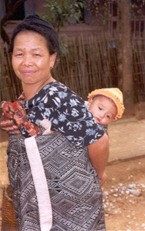The Chinese government recognizes the Khang, a sub-group of the Dai, as one of their official ethnic minorities. People in neighboring countries still call the Khang the Tai or Thai, as they knew them until the 1950s. The Khang's classification is uncertain. Some scholars believe they are more closely related to the Dong minority than to the Dai.
Most of the Khang live in the southwestern corner of Yunnan Province, near the Laotian border. Some live in Laos. In general, they live a little further north than most other Dai groups. The Khang homeland abounds in beautiful mountains, valleys and streams. It has a subtropical, spring-like climate year round. Every year includes a rainy and a dry season. Palm trees, banana trees and bamboo grow in abundance. Animals such as elephants, tigers, leopards, bears, monkeys, and peacocks live there.
Most of the Khang farm for a living. They grow rice, their primary crop, though they usually only reap a small harvest. They also grow tea, cotton, sugarcane, tobacco, coffee, pineapples, and mangoes. Farmers still use traditional hand instruments, such as wooden hoes and sickles to plow, plant, weed and harvest.
Although many villages are larger, most Khang villages have about 30 to 40 households. Huge banyan trees and delicately designed Buddhist temples or pagodas are in a typical village. Most Dai-related people build houses from bamboo, setting the houses about six to nine feet above ground on 21 wooden posts in three rows. People use the area below the houses as a shelter for livestock. Builders use bamboo for walls and rafters and thatch the roofs. They divide the interior of the houses lengthwise into two rooms.
Annually, the Khang, along with all other Dai groups, hold a famous celebration known as the Water Sprinkling Festival. Today attendees celebrate the festival more as an expression of Dai culture than as an observance of a Buddhist holiday as they did in the past. It's a very popular event for tourists. During the festival, the Dai build small sand replicas of pagodas, listen to monks reciting prayers, venerate a statue of Buddha, and sprinkle each other with water.
At one time, parents sent their eight or nine-year-old boys to a Buddhist temple. The boys lived as a monk for at least two years, but more often for ten years. Temple officials gave the boy a new name. If he chose to leave and return to secular life, the officials gave the boy another new name. Upon the birth of his first child, officials would give the man and his wife each yet another new name. During the Cultural Revolution in the 1960s, the Chinese repressed this practice, but today it is making a comeback.
Many of the Khang follow Chinese folk religions. They add elements of Buddhist, Confucian and Taoist to their spiritual beliefs. The Khang also consult horoscopes to determine which course of action will promote harmony and bring good luck. The goal of their blended religion is to maintain spiritual harmony.
The Khang also believe in a pantheon of spirits who inhabit the earth. They believe the spirits of their ancestors roam the earth. If the people treat the spirits properly, the spirits will bring good luck. The Khang believe deities are the souls of people who lived especially virtuous lives. Deities supposedly use spiritual powers to benefit their worshipers.
Those who are living in rural China like the Khang are not improving their economic situation. They have physical as well as spiritual needs in today's China.
Pray for Holy Spirit led laborers to share Christ's love with the Khang people.
Pray for a Khang Bible translation, audio recordings, JESUS Film and online audio New Testament resources to be spread throughout Khang communities.
Pray that God will save key leaders among the Khang who will boldly declare the gospel, leading to a healthy and growing church for the glory of his name.
Scripture Prayers for the Tai Khang in China.
| Profile Source: Joshua Project |












